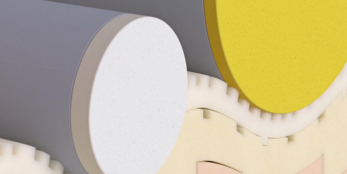Before working with this product, you must read and become familiar with the available information regarding its risks, proper use, and safe handling. This information is provided in various formats, including the current Safety Data Sheet (SDS) and product label. SDS can be accessed via the following link:
Safety Data Sheets (SDS) for Covestro products | Covestro
For further questions, please use the contact information provided on this technical data sheet.
Product description
Texin 983A resin is a polyether-based thermoplastic polyurethane; it can be processed by injection molding or extrusion.
Applications
Texin 983A resin offers outstanding abrasion resistance, impact strength, toughness, and flexibility. It also exhibits excellent hydrolytic stability. Texin 983A resin complies with FDA food-contact regulations 21 CFR 177.1680 (Polyurethane Resins) and 177.2600 (Rubber Articles Intended for Repeated Use), subject to the limitations of these and and other applicable regulations.Applications include belting, hose, seals and gaskets, tubing, cable jackets, hose jackets, athletic soles, casters, mine screens, film, and extruded profiles. As with any product, use of Texin 983A resin in a given application must be tested (including but not limited to field testing) in advance by the user to determine suitability.
Storage time
Texin thermoplastic polyurethane resins are hygroscopic and will absorb ambient moisture. The resins should remain in their sealed containers and stored in a dry area. Storage temperatures should not exceed 86°F (30°C). Unused resin from opened containers, or reground material that is not to be used immediately, should also be stored in sealed containers under cool and dry conditions.Prior to processing, Texin 983A resin must be thoroughly dried for a minimum of 4 hours in a desiccant dehumidifying hopper dryer to a moisture content of less than 0.03%. Hopper inlet air temperature should be 180°-200°F (82°-93°C), the inlet air dew point should be -20°F (-29°C) or lower.Where end-use requirements permit, up to 20% Texin resin regrind may be used with virgin material. Regrind material must be generated from properly molded/extruded parts, sprues, runners, trimmings, and/or films. Degraded or discolored material may not be used for regrind. All regrind material must be free of contamination and thoroughly blended with virgin material prior to drying and processing. Finish parts containing regrind must be tested to ensure that end-use requirements are fully met.
Processing
Typical starting conditions for injection molding, extrusion, and blow molding are noted below. Actual processing conditions will depend on machine size, mold design, material residence time, shot size, part geometry, etc.
Health and Safety Information
Disclaimer
Responsibility and Liability
The use of Covestro products, technical assistance, and information (regardless of how provided) is outside Covestro’s control and is solely the responsibility of the customer. The customer must conduct adequate testing to determine the suitability of products for its intended use, including but not limited to technical, health, safety, and environmental aspects. Unless otherwise agreed in writing, all products are sold exclusively under Covestro’s standard conditions of sale, which prevail in case of conflict and are available upon request.
The terms and conditions of sale and delivery are available via the following link:
https://order.covestro.com/covestrostorefront/saleConditions
All information is provided “as is” without warranties, express or implied, including merchantability or fitness for a particular purpose, and is subject to change without notice. To the maximum extent permitted by law, Covestro disclaims, and the customer assumes all liability for losses, damages, or claims arising out of use of Covestro products, technical assistance, or information. Any statement or recommendation not expressly contained in Covestro documentation is unauthorized and shall not bind Covestro. Nothing herein shall be construed as encouraging or recommending the use of any product in conflict with any claim of any patent. No license is implied or in fact granted under the claims of any patent.
Restrictions on Regulated Applications
This product is not intended for use in regulated applications such as agriculture, cosmetics, drinking water contact, food contact, medical products (e.g., medical devices), toys, or similar uses subject to specific regulatory requirements. Prior written approval from Covestro is required before this product may be used in any regulated application. The customer is solely responsible for ensuring compliance with all applicable laws and determining product suitability. Covestro disclaims all liability and warranties for unauthorized regulated uses.
Typical Value
These values are provided as typical data only and do not constitute binding specifications or warranted performance, unless explicitly agreed by Covestro in writing. Performance may vary depending on factors including, but not limited to, mold/die, processing conditions and coloring/pigmentation. Unless otherwise stated, values are based on standardized test specimens at room temperature.
Sample
Samples provided by Covestro are intended solely for evaluation and testing purposes by the customer and may not be used in commercial applications, resold, transferred to third parties (except qualified testing service providers acting on behalf of the customer), reverse engineered, modified, or used in any manner not explicitly authorized in writing by Covestro. Samples are provided ‘as-is’ without any warranties, express or implied, including fitness for a particular purpose. Customers are solely responsible for ensuring safe handling, regulatory compliance, and suitability of the material for their intended evaluations. Covestro disclaims all liability for damages or losses arising from the use of samples.
Contact Information
Please use our contact form or contact us directly by sending an e-mail to technical-datasheets@cx.covestro.com .








